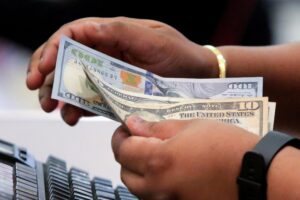
The U.S. dollar reached an eight-week peak against major currencies, driven by the recalibration of Federal Reserve rate cut expectations due to signs of enduring strength in the U.S. economy. The greenback’s rise was evident as it hit its highest since December, with the dollar index peaking at 104.18.
This upward trajectory saw the yen, along with the Australian and New Zealand dollars, descend to two-month lows. The euro also felt the pressure, dropping to a more than one-month low of $1.07675 against the robust dollar.
The market’s reassessment of the Federal Reserve’s monetary policy stance was significantly influenced by the unexpectedly robust U.S. jobs report released on Friday, which surpassed market forecasts. This development, coupled with Federal Reserve Chair Jerome Powell’s remarks indicating the improbability of a March rate cut, has led traders to adjust their expectations.
Chris Weston of Pepperstone encapsulated the sentiment, stating, “A one-two punch from Jay Powell’s FOMC presser and a very strong nonfarm payrolls report have essentially closed the door on a March rate cut.” Reflecting this sentiment, the CME FedWatch tool indicates a mere 20 percent likelihood of a rate easing in March, a stark contrast to the nearly 50 percent probability estimated a week prior.
In a recent interview on the “60 Minutes” news show, Powell emphasized the Fed’s capacity to exercise prudence in rate cut decisions. This discretion is underpinned by the current strength of the economy, which allows central bankers the latitude to ensure confidence in the continuing deceleration of inflation.
Despite these dynamics, the currency market exhibited notable movements. The Japanese yen depreciated slightly to 148.58 per dollar, touching a session low of 148.82 earlier. The Australian dollar saw a decrease of 0.33 percent to $0.6490, while the New Zealand dollar declined 0.25 percent, last trading at $0.6050. The British pound also experienced a downturn, reaching its lowest point since January 17 at $1.2600.
Carol Kong of the Commonwealth Bank of Australia projected, “The dollar is likely to hold on to its recent gains,” a sentiment bolstered by the surge in Treasury yields. The two-year yield, closely mirroring near-term rate expectations, rose significantly, last seen up nearly seven basis points at 4.4386 percent. The benchmark 10-year yield increased by five bps to 4.0829 percent.
Meanwhile, China’s financial markets and currency faced their own challenges. Despite the Chinese securities regulator’s commitment to mitigate abnormal market fluctuations, Chinese stocks hit five-year lows, and the offshore yuan fell to a more than two-week low of 7.2225 per dollar before marginally recovering to 7.2182 per dollar.
Amidst these market dynamics, Kong noted the need for more concrete measures to substantively bolster the yuan, highlighting that current speculation and media reports have yet to translate into decisive actions from the Chinese government regarding market support measures.
As global markets react to these economic signals and policy indications, the strength of the dollar remains a focal point, with its trajectory closely tied to the unfolding monetary policy decisions and economic data.






















Comments are closed for this article!